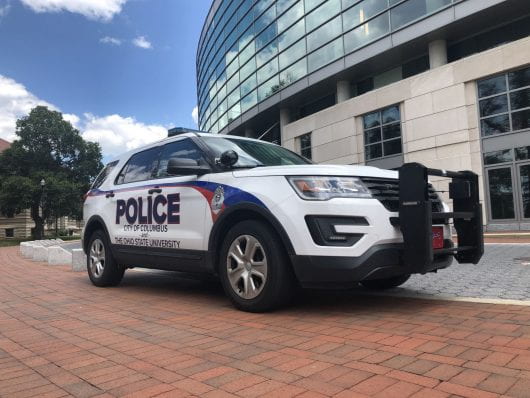
A police vehicle shared by both University Police and Columbus Police. The university announced in a Tuesday email the creation of a Public Safety Advisory Committee to address students’ concerns about Columbus Police presence on and off campus. Credit: Sarah Szilagy | Campus Editor
Ohio State will create a Public Safety Advisory Committee within the Department of Public Safety as one part of its effort to address students’ concerns about interacting with Columbus Police, according to a Tuesday universitywide email.
The committee will include students, faculty, staff and other “non-university stakeholders” and will be active by the end of July, the email states. In addition to creating a public safety action plan, the committee will develop required training material for non-University Police officers to review before they are assigned to university events.
The email comes after more than a month of protests following the death of George Floyd and other Black Americans who have died due to police violence and after an open letter written — which had 25,243 signatures by the time of publication — by leaders of Undergraduate Student Government, the Inter-Professional Council and the Council of Graduate Students urging the university to sever ties with Columbus Police. It also comes after students have been pepper-sprayed, tear-gassed and detained by Columbus Police during protests.
“Students have had encounters with the Columbus Division of Police that do not uphold Ohio State’s expectations for how our students should be treated – and supported – when peacefully protesting. This includes the pepper spraying of student journalists, who appeared, based on a video recording, to be rightfully and lawfully exercising their right to cover an important event in the city,” the email reads. “This type of interaction is both disheartening and unacceptable.”
Roaya Higazi, president of Undergraduate Student Government, said she has been meeting with university administrators over the past several weeks to discuss plans to create a safer environment for students both on and off campus. She said that although having a committee — particularly a committee that includes Black students — is a good first step, ensuring students’ safety will take more action.
“The ultimate goal is decreasing police presence, and that’s what we are going to continue to push for,” Higazi, a fourth-year in city and regional planning, said.
The email also outlines other steps the university is taking to address student safety. Although University Police will file for joint-patrol with Columbus Police for 2021, the university is planning to pursue a selection-based process for non-university officers as opposed to its current system based on seniority, according to the email. The university will also advocate for more University Police officers on joint patrol.
Higazi said many messages she’s received from students are related to the proportion of University Police to Columbus Police in joint patrol areas and that increasing University Police presence in these areas is key.
She also said the university’s current plan addresses other demands the student governments made, like participating in the Law Enforcement Support Office 1033 Program, which provides police forces with military vehicles and other equipment.
According to the email, there are no current plans for University Police to receive military-grade equipment, but any future plans will be reviewed by the committee.
Over the next several months, the university’s task force on racial disparity — announced June 10 and led by James L. Moore III, vice provost for diversity and inclusion and chief diversity officer, and Tom Gregoire, dean of the College of Social Work — will work with the community to take more steps in establishing a more inclusive, safe environment for Black students and students of color, according to the email.
“Swift action is important, but sustained change is essential,” the email reads.


